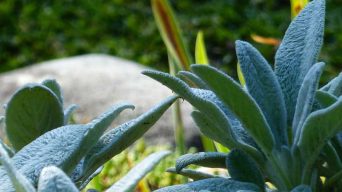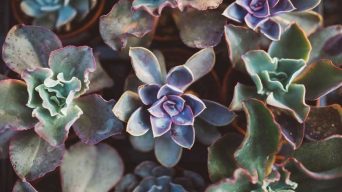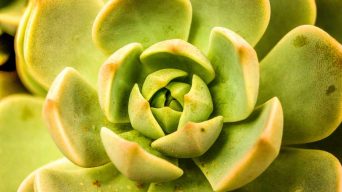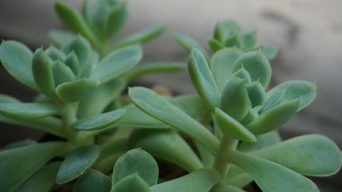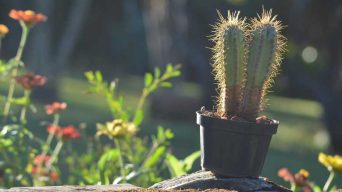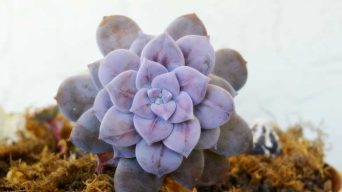Succulent leaves curling down can be a cause for concern.
If this is happening to your succulents, you might worry that they are dying or have some kind of disease.
It’s important to know the reasons why succulent leaves curl down and how to fix them so it doesn’t happen again and they can grow healthy.
Why Are My Succulent Leaves Pointing Down
There are a few different reasons why succulent leaves might be curling down.
The most common reasons are:
Overwatering
Overwatering is the number one cause of succulent leaves curling down. If you see your succulent leaves turning brown, wilting, or curling down and drying out, then you have been overwatering your succulent.
To avoid overwatering your succulent plants, ensure the soil can absorb the water and has time to dry out before getting wet again.
After watering, wait until all visible signs of moisture have disappeared before giving succulents another drink.
Additionally, it would be best if you watered your succulent in the morning and not later on at night.
This is because succulents are chiefly nocturnal plants, which means they absorb moisture from the soil during nighttime hours when it’s cooler outside.
Also, make sure that there isn’t too much of a difference between daytime temperatures and nighttime temps. You don’t want to overwater right before sundown. This can cause root rot due to fluctuations in temperature or humidity levels.
Underwatering
Common signs of an underwatered succulent are curling leaves and if left untreated for too long, wilting.
Underwatering is when your succulent doesn’t get enough water. This could happen because of insufficient drainage in the soil or watering too little often.
Another reason for underwatering can be that you’re using a porous pot and not an absorbent one to allow more airflow around the roots.
If this is the case, then change out your container with something like terracotta clay pots, which are better at absorbing moisture than plastic ones.
You may also need to increase how frequently you’re giving them water if they don’t seem to be getting their fair share of what nature provides.
Give succulents some time between watering sessions since plants will grow faster with adequate rest periods before each irrigation.
Poor Lighting
One of the main reasons why your succulent may have curled leaves is due to not having enough sunlight.
A succulent plant, like other plants, needs a certain amount of light each day for it to grow properly and become healthy and full of life.
Some common signs that a succulent is not getting enough light are the leaves curling down and, in some cases, any new growth will be stunted.
This can happen for a variety of reasons, such as:
- Too much shade from other plants or structures on top of your succulent.
- Not enough natural light coming into your home due to windows being shaded by curtains.
- You live somewhere with less than optimal weather (such as cloudy skies).
If you are struggling with getting enough sun on your succulents, consider placing them near an east or west window where they will get more direct sunlight, compared to being by a north-facing window.
Putting them outside during the summer months also has excellent benefits but keep in mind their temperature requirements which can vary depending on the species.
Too Much Sunlight
If succulent leaves are curling down, it is usually because they received too much sunlight.
This can occur if the plants are receiving a lot of sun during the day. The succulents need to be moved into partial shade until their leaves uncurl again.
Some of the signs that can tell you if a succulent is receiving too much light are:
- The succulents are turning a brown color.
- They may have dry leaves that curl downward from the sunburned tips.
- Brown spots form on the succulents’ surface due to drying out in hot sunlight or being exposed to cold winds.
Succulents thrive in partial shade or dappled sunlight.
When planting succulents in your garden, make sure that some areas receive less direct sunlight not to burn them when exposed for long periods at time.
If you have an overhead tree canopy that shades one side of your yard, this might work well! Succulents will also do better with morning sun rather than midday heat; before noon is best!
Lack of Good Drainage
Most succulents need good drainage, so when they are planted in pots or containers with poor drainage, the water will pool and stagnate in a container.
This can lead to root rot or other fungal diseases that may cause leaves on your plants to curl down. This is a big problem because it could lead to the death of the plant.
The first thing you should do is add drainage holes to the pot or container. You can also repot your succulents in a new pot with better drainage; they will take root and become a healthy plants again soon enough.
If you have poor soil, mix more sand into the top layer of dirt to help improve its ability to drain excess water from the surface.
If this doesn’t work, try adding some perlite (a type of volcanic rock) onto your garden bed for added aeration when watering plants. This might be needed to keep those leaves upright on their stems!
Using Regular Potting Soil
Regular potting soil is not the best for succulents because it doesn’t have enough drainage.
When succulents are not potted in well-drained soil, they will likely end up with succulent leaves curling down. The problem is that the water doesn’t drain well, and it gets too wet around the roots of succulents, so they start to rot.
One way to deal with this problem is by using a succulent potting mix that has more perlite and sand in it, or try mixing regular potting soil with amended topsoil.
Another option could be adding rocks to your container so water can drain out of it more easily. The stones will also create some excellent aesthetic features on their own while providing great drainage at the same time!
This way, the root system won’t get too wet and can take in nutrients more easily than before, which is ideal because dryness worsens leaf curl problems.
Pot Size Issues
When succulents are grown in a pot that is too small, their roots will be unable to access all the water and nutrients they need.
On the other hand, when succulents are grown in a too large pot, their roots will not be able to anchor the plant securely. In these cases, the succulents will show signs such as curling, drooping leaves, and thin stems.
The recommended pot size for succulents is a pot that will allow the roots to spread out but not too far to touch the edge of the container.
A rule of thumb would be at least one inch between each plant and two inches from side to side.
Root-Bound
When succulents are not repotted regularly, they can become root-bound. This means that the roots of their pot have grown so densely around it that they eventually restrict the plant from taking up nutrients as it should.
As soon as you notice new leaves curling down, wilting, or yellowing, give your succulent some fresh soil to breathe in by repotting it into a larger container.
If you’re not sure if your succulent is root-bound, gently pull up the plant and inspect the roots. If they circulate around a small pot or ball of dirt in all directions, it must be repotted immediately.
Succulents may also need more water than usual if root-bound because their roots can no longer absorb nutrients from the soil.
Remember that succulents should only be watered when dry (not wet) so make sure you give them enough time between watering sessions for this reason!
They Haven’t Had Time To Adjust to Their Environment
One common reason succulent leaves are curling down is that they haven’t had time to adapt to their new environment.
Succulents need time to acclimate, so give them some time, and they’ll adjust themselves.
It may take them a few weeks to get used to the amount of sunlight and water available. Ensure you’re giving them plenty of both during this adjustment period.
This will help keep your succulents looking healthy!
Pest Infestation
One common reason why succulent leaves are curling down is because they have a pest infestation.
Pests like aphids, mealybugs, fungus gnats, and spider mites will damage plants by feeding on their sap or injecting them with toxins.
The bugs also act as carriers for other diseases, such as rot, rust, and viral infections, leading to plant death if not treated.
To fix this problem, you need to identify what type of pest has invaded your succulents first to know how best to remove it.
For aphids, the best course of action is to remove and destroy any plant material that they are feeding on. You can also use a strong jet from your garden hose to knock them off onto nearby plants or bare soil, where they will be easier to kill.
If you have spider mites, then it’s time for some pesticide. Mite-killing pesticides such as soaps, horticultural oils, and insecticidal soaps should do the trick if applied regularly.
For mealybugs, you’ll need an oil spray with pyrethrum to suffocate them. One good way of killing these pests is by using rubbing alcohol since it contains high percentages of ethanol which dehydrates insects.
Just make sure not to get this near any other plants.
Final Thoughts
In conclusion, succulent leaves curling down is a pretty common succulent problem.
With the understanding of the underlying reasons and what they mean for your succulents, you should be able to diagnose why your plant leaves are curling down.
This will help you to take the necessary measures so that your succulents can grow healthy.


